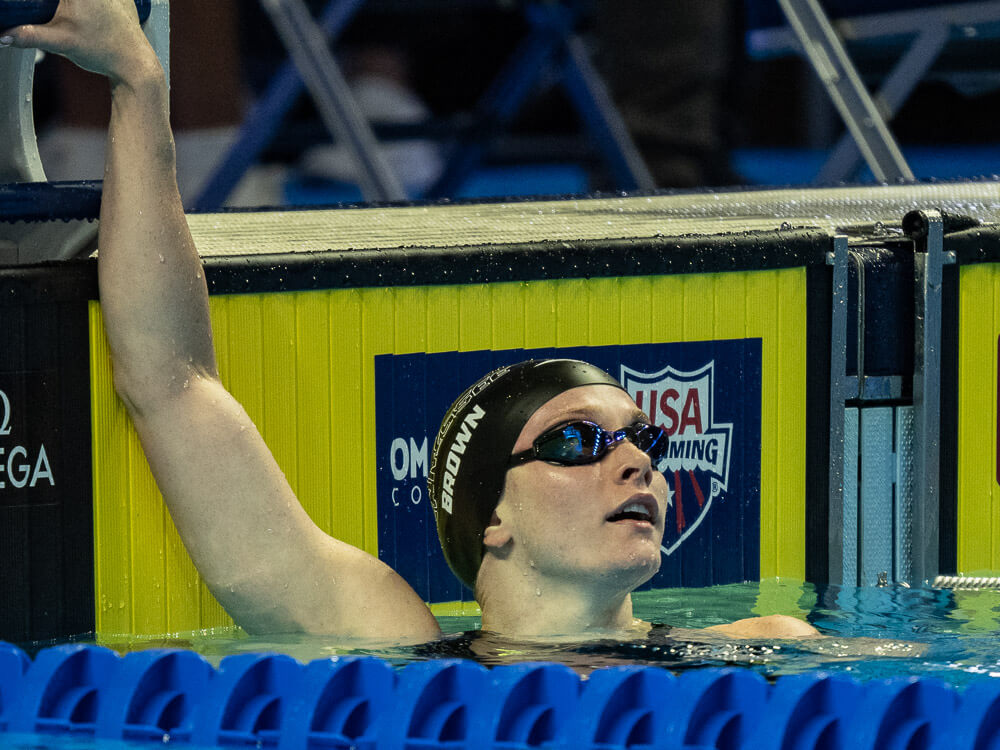U.S. Olympic Trials, Day 7 Notebook: How Erika Brown Reinvented Herself to Make Tokyo

U.S. Olympic Trials, Day 7 Notebook: How Erika Brown Reinvented Herself to Make Tokyo
In the fall of 2017, University of Tennessee sophomore Erika Brown was one of the feel-good stories of college swimming as she propelled herself from a non-NCAA qualifier as a freshman to one of the country’s top sprinters by sophomore year. By the end of that season, she was SEC champion in the 50 free, 100 fly and 100 free, and she finished second at the NCAA championships in the 50 free and 100 fly.
But that was all in short course. Her biggest weapon was a mighty underwater dolphin kick that she used to cover more than half the distance in each of her races. Long course, Brown was not there yet. At U.S. Nationals in 2018, Brown finished 15th in the 100 free, 14th in the 50 fly, 12th in the 100 fly and 14th in the 50 free.
“That summer was really difficult. I did not perform the way I wanted. I think everything happens for a reason. It motivated me to continue working really hard and really focusing on all the details,” Brown said. “Obviously my underwaters really helped me in short course, so I had to focus on my stroke and distance per stroke and making those turns really count, so accelerating into the those turns, and I can’t use as many underwaters, so I really had to focus on my stroke.”
Over the course of a few years, Brown figured out long course racing. But while she was primarily a butterflyer first and a freestyler second in her college career, it would be freestyle that brought her to a level where she could be competitive in long course. In a year and a half, she dropped her time from 54.5 to 53.4, which she swam in December 2019 and again in January 2020. With up to six spots available on the women’s 400 free relay at the Olympics, she looked to be in good shape to challenge for an Olympic team.
After the Olympic delay and a successful ISL season with the Cali Condors, Brown had not recorded any super impressive times in 2021 prior to Trials, her season-best effort in the 100 free a 54.45. And her Trials got off to a rough start when she finished 32nd in the 100 fly, her time of 59.82 more than a second off her best time. Then she was 25th in the 200 free in 2:00.82, this time more than three seconds off her seed time. In the 100 free, Brown was seventh in prelims and eighth in the semifinals, squeaking into the final by just 0.02 over reigning Olympic gold medalist Simone Manuel.
“I was pretty disappointed with how my 100 fly and 200 free went,” Brown said. “But I’ve mainly been training for this 100 free and 50, so I just tried to keep a positive attitude and focus on what I was here to do, and with every 100 I swam, I got better.”
Brown was in lane eight, far away from the rest of the field—but she went out fast and got the job done. She flipped second and held onto that position, touching in 53.59, securing the spot in Tokyo that, despite all her success, seemed so unlikely at many points over the past few years.
Ryan Murphy Trials Comparison
Defending double backstroke gold medalist Ryan Murphy took care of business in qualifying for his two events at the Tokyo Olympics, and despite an imperfect five years where he never won any individual world titles, he’s in position for another strong effort at the Tokyo Games. Neither of Murphy’s swims this week overtook Russian rivals Kliment Kolesnikov or Evgeny Rylov in the world rankings or otherwise lit the world on fire, but he ended up being just off his winning times from the 2016 edition of these Trials.
- 100 back: 2016 – 52.26; 2021 – 52.33 (52.22 in semifinals)
- 200 back: 2016 – 1:53.95; 2021 – 1:54.20
Maybe Murphy and his coach, Dave Durden, could leave a little more in the tank this week knowing that he was a heavy favorite to win both backstroke events, compared to 2016 when the 100 back was one of the most anticipated events on the program. Murphy’s relaxed demeanor all week hints that he will have more in the tank and be ready to go head-to-head with the Russians and China’s Xu Jiayu in Tokyo.
The World Record Drought
After the banning of the full-body polyurethane suits after 2009, world records became scarce for several years, and even now, you don’t see any sort of record surge compared to the 43-record World Championships in 2009. In the United States, they have been even more rare. The last 11.5 years have seen just six long course world records set on U.S. soil. Five of those, unsurprisingly, were Katie Ledecky’s swims, three in 2014, one in 2016 and one in 2018, and the other was Kathleen Baker’s 100 back at the 2018 U.S. Nationals.
No man has set a world record on U.S. soil since 2009. Only three American men have set world records at all during that span, all at international events. That was Ryan Lochte in the 200 IM at the 2011 World Championships, Murphy in the 100 back at the Rio Olympics and Caeleb Dressel in the 100 fly at the 2019 World Championships.
Why bring that up at all? Because Dressel swam the third-fastest time ever in the 100 fly in Friday’s semifinal at 49.76, faster than Michael Phelps or Milorad Cavic or anyone besides Dressel himself has ever swum. And Dressel was only out in 23.31, almost a half-second off his world record pace. He came home in a ridiculous 26.45, compared to 26.67 two years ago.
No one has set a world record at U.S. Trials since 2008, and there would be another record drought almost as long broken if Dressel gets under his own 49.50 in the finals.


- 2016 USA TRIALS ARCHIVE
- ARCHIVES OF OLYMPIC TRIALS VIA SWIMMING WORLD VAULT
- 2021 USA OLYMPIC TRIALS WAVE I CUTS
- 2021 USA OLYMPIC TRIALS WAVE II CUTS
- HEAD USA OLYMPIC COACHES
- 2016 FULL RESULTS
- WAVE I FULL RESULTS
- PSYCH SHEET
- DAY ONE RESULTS
- DAY TWO RESULTS
- DAY THREE RESULTS
- DAY FOUR RESULTS
- DAY FIVE RESULTS
- DAY SIX RESULTS
- DAY SEVEN RESULTS
- DAY EIGHT RESULTS



